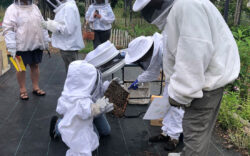Whether you’ve got a few potted gems on your porch or a whole front-yard garden, you can’t rely on rainwater for irrigation anymore. Watering is one of those seemingly simple plant-care tasks that can get tangled.
I find that watering more deeply but fewer times is the best practice. Part of that comes from my experience working in a greenhouse. “When you think you’ve watered enough, water it one more time,” Greenhouse Boss Man once said. The lesson stuck. Part of my belief comes from my garden’s clay soil, which retains moisture much longer than sandy soil does.
I check moisture levels by looking at my garden in the morning. If I already see some drooping leaves at 9 a.m., I know it’s best to water. If I’m not sure, I stick my finger into the soil near a few plants. Moisture in the first inch means I can hold off for another day. Here’s a few watering tools and when I think they work best:
Watering can
For: Small gardens, meditative watering
The best watering cans are the ones with a spout diffuser. The single-spout watering cans are pretty, but don’t mimic actual rainfall and can crush tender seedlings. Single-spout watering can redistribute loose soil and disturb small roots. Durable plastic is the way to go here, though there are some nice metal options.
Garden wands and hose nozzles
For: Small to medium gardens
This is a great tool, though it did take some time for me to find one I didn’t break in a month. Choose a nozzle with more metal than plastic parts, and you’ve got a good chance of keeping it long term. If it has more than two or three options, I feel like I spend more time trying to find the best setting than actually watering.
Misters
For: The smallest and most sensitive of seedlings
Some seeds, like lettuce, need sunlight to germinate and grow. Wetting them with a standard nozzle or watering can causes soil to wash over the seeds. Misters spray just enough to soak the seeds and soil without disturbing anything. It works well, but can take some time to adequately bathe your seeds.
Bottom watering trays
For: Indoor plants, potted plants, seedling trays
Does it cut down on soil-borne diseases? Yes, definitely. Can it take a longer time if you have a bunch of plants and tend to get easily distracted? Yes, which is why it’s not my go-to method for most potted plants. I typically use bottom watering when I notice my front porch ferns looking crispy. If the soil is dry enough, it can become hydrophobic and actually repel water for a time. Sticking the fern in a shallow pool of water and letting it sit for an hour or two solves the problem.
Sprinklers
For: Playing, establishing clover lawns, wildflower patches
If you’ve got a sprinkler setup in your garden, and you’re happy with it, good for you! Mostly, I think sprinklers give cute kids and dogs something to play in during the heat of the summer. It also can help establish larger plots with wildflower fields or clover-filled lawns. Otherwise, sprinklers waste quite a lot of water. I know some gardeners and farmers who swear by their sprinklers, so it might just depend on your experience.
Soaker hose
For: Small to medium gardens
If you’ve got a small garden, this is a great option. It’s easy to hook up, fairly economical, and a $75–100 hose will last for years. Soaker hoses slowly distribute water to the plants along its path, so you will have a bit of a geometry problem when you set it up. These hoses do attract fire ants, particularly when they’re searching for water in drier weather, so keep an eye out and a bag of diatomaceous earth ready, just in case.
Irrigation tape or t-tape
For: Medium to large gardens
The most expensive option by far, but the one that uses the least amount of water. Spring for the thicker plastic (I have the 15 mm) because the thinner the plastic, the easier it is to puncture. I’ve seen yards and yards of thin-walled irrigation tape wind up in the trash after a few waterings. This is another geometry problem, and you’ll also have to figure flow rates.
Like what you just read? Support Flagpole by making a donation today. Every dollar you give helps fund our ongoing mission to provide Athens with quality, independent journalism.










